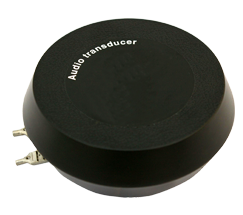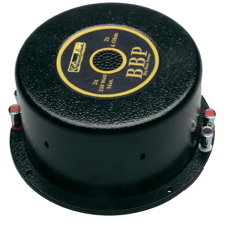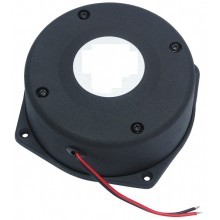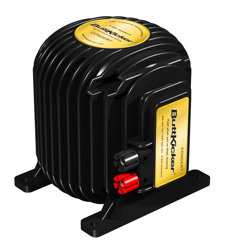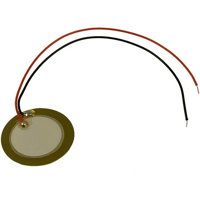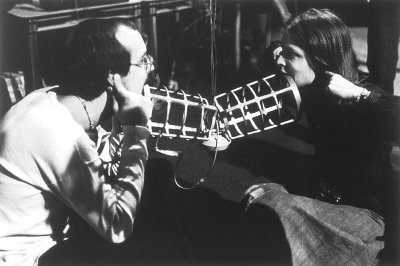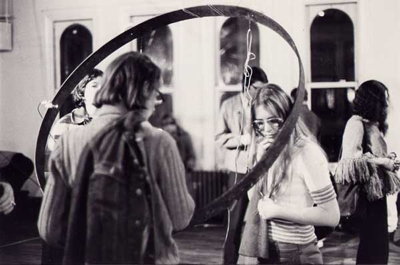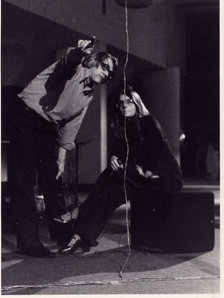Research Studies/Études & Recherche : — [Studies - Environmental Music / Études Œuvres Environnementales]— [Research] —
RAINFOREST (DAVID TUDOR)deuxième partie / Part 2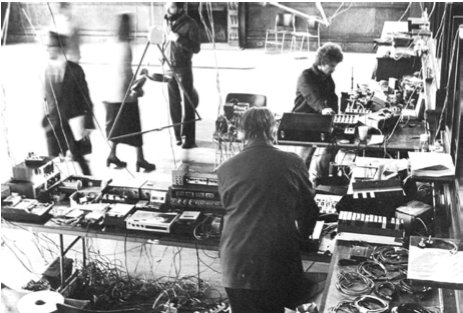
|
— Part2 — La Partition Rainforest — Le Dispositif-Circuit — Les Résonateurs — Le Déroulement d'une performance Rainforest — La Participation des Auditeurs et la Place de l'Écoute — Les Enjeux Musicaux de Rainforest — Références
— Part 3 — Rainforest IV par NoEnsemble
- ► La partition de Rainforest
- ► Le dispositif-circuit
- ► Les résonateurs (sculptures)
- ► Le déroulement d'une performance de Rainforest
- ► La participation des auditeurs et la place de l'écoute
- ► Les enjeux musicaux de Rainforest
- ► Bibliographie & Références Urls
- ► Références médiatiques
- ► Références iconographiques
Le dispositif-circuit(Edit)
La notion de circuit est essentielle dans les œuvres musicales de David Tudor, même si l'expression l'œuvre est le circuit semble provenir d'un autre compositeur américain, Gordon Mumma. Tudor imagine dans les années 60 et 70 des œuvres musicales qui mettent en interaction continue performeurs, espaces acoustiques, dispositifs électroniques et auditeurs. Ce circuit de production sonore et technique, et de réception, apparaît comme un ensemble de boucles (feedback) : c'est-à-dire des circuits d'interactions entre les différents éléments et activités du dispositif général. Cette œuvre ne peut être fermée, ne peut être écrite, ne peut constituer une partition qui serait à rejouer, sinon la description du circuit prototype qu'il s'agit de mettre en place de manière multiple dans un espace afin de le jouer et de le rendre sonore.
| (à traduire) Tudor himself speaks cryptically about his own electronic set-ups (tables full of audio components and their associated tangled cabling). It is the choice of specific components and their interconnection that define both the composition and performance of each of his pieces. [...] One of his objectives in the 60's and 70's was to generate sound without using any input source material. Freeing himself from a more conventional composer-instrument relationship, Tudor's compositional approach allowed his electronics to 'do the talking'. [...] By returning part of the output of a circuit back to its input, essentially creating an electronic loop, Tudor could generate new sound entirely through electronic means. This principle is known as feedback oscillation. [...-] The greatest appeal of these oscillatory rhythms for Tudor was their extraordinary degree of variability and unpredictability. [...] [In "Untitled"] He designed two integrated chains of audio components, piling up the varied gain stages and finally connecting each of the chains back onto itself with the goal of creating one giant, self contained, stereo feedback oscillator. There were two key methodological ingredients in Untitled, one was the use of what Tudor coined as 'phase shift oscillation', the other was variable side-band modulation (a type of analog multiplication using two input signals). Phase shift oscillation is a variation of feedback oscillation where the audio signal is that is fed back to the input is altered by between zero and 360 degrees of phase. As his work progressed Tudor discovered that the oscillation he was achieving wasn't only about feeding back resonant (but otherwise non oscillating) circuits, it was also the specific configuration of these circuits and how they were allowed to share with each other, their instabilities. As Mumma recently observed, '...David developed a virtuosity in the chaotic fields between 'resonance' and 'oscillation'." It was at this point in his experimentation that Tudor made an important observation. He recognized that the standard arrangement of "inputs" and "outputs" on some of the components could be used more as universal "ports". He found that if he connected certain circuits together backwards (using the output as an input and vise-versa), unpredictably exciting results would often occur.— (John D.S. Adams, "Giant Oscillations") |
| (à traduire) ""Eventually you discover certain critical points in a circuit, and its those that you pay attention to when things are misbehaving. The last resort is always to cut it off completely and start over - that's perfectly acceptable. As a matter of fact, that's part of the whole operation. I found that very rarely did I feel that there was an unacceptable situation, even though I don't like it when feedback takes off. But after all, having so many points with which to create variation... I guess what I'm trying to say is that since it's suppose to be an unpredictable oscillation, that's the condition in my mind. So when it stays in a so-to-speak static state, then that's when I have to grapple. If I get it balanced, it's constantly producing a variety of itself. That's the image that I have... that it should be producing this variety." — David Tudor in interview with John Fullemann (Aug. 31, 1984) - quoted in John D.S. Adams, "Giant Oscillations") |
| Une chose que j'ai essayé de faire en amenant ce générique de "Composers Inside Electronics" était de comprendre que la réalisation d'un circuit électronique, ou simplement un de ses composants, peut sembler avoir une "personnalité" ou "un comportement", de manière très proche de celle que j'ai tenté avec les haut-parleurs en leur attribuant à chacun une "voix" spécifique. Si vous regardez de près un appareil que vous allez acheter, comme par exemple un filtre ou une mixette, et qu'en fait vous essayez de tester ces capacités, vous devez repousser celles-ci, et demander à cette machine de faire quelque chose qu'elle est incapable de faire. Quand vous faites ce type d'expérimentation ou que vous menez ce type de pratique, vous découvrez des choses qui vous semblaient insoupçonnées et qui pourtant arrivent et se produisent parce que vous êtes en train d'infléchir et d'agir sur l'électronique même. Par exemple, prenez l'expérience standard d'utilisation de feedback : prenez simplement la sortie de quelque chose et connectez-là à l'entrée de ce même appareil. Ceux d'entre nous qui ont testé ce type de choses ont vraiment eu une expérience plutôt riche de découvertes. Et il est évident que ce type d'expérimentations et d'expériences peut et doit continuer. Et ainsi c'est un vrai champ exploratoire de production [sonore et musicale] qui peut continuer de se développer. [1] — David Tudor, from An Interview with David Tudor by Teddy Hultberg in Dusseldorf, May 17-18, 1988, http://davidtudor.org/Articles/hultberg.html |
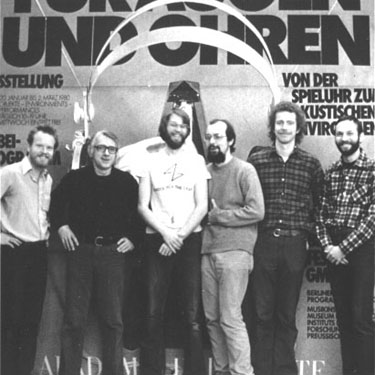 | Composers Inside Electronics — Berlin, 1981 - Ralph Jones, David Tudor, Philip Edelstein, Bill Viola, John Driscoll, Martin Kalve. Photo by Rene Block. CIE is a group of composer/performers dedicated to the composition and live performance of electronic and electroacoustic music using circuitry designed and constructed by the individual composers.The group was founded in 1973 when they collaboratively realized the electroacoustic environment, Rainforest IV, conceived by David Tudor, at New Music in New Hampshire. After many subsequent performances of this work in American universities and galleries CIE introduced new works to their repertory by other group members at the Festival d'Automne in Paris, 1976. This trend of collaboratively realizing individually conceived works has continued: since September 1978 a group of new works were presented in New York and other places. This newly formed group (Paul DeMarinis, John Driscoll, Phil Edelstein, Linda Fisher, Ralph Jones, Martin Kalve, and Bill Viola) became the collaborative nucleus for Rainforest IV and have performed the work for well over 500 hours total. Over the years a number of different composers/performers joined in peformances including David Behrman, Cynthia Black, Nick Collins, Russel Frehling, Takehisa Kosugi, Virginia Quesada, Prent Rodgers, Ann Sandifur, Richard Teitelbaum, and Andrej Zrajic. — (David Driscoll) | |||||||||||||||||||||||||||||||
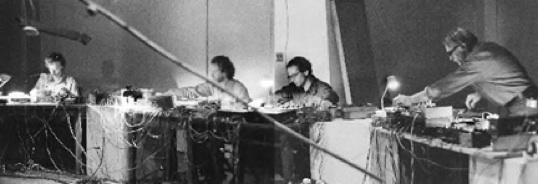 | Composers Inside Electronics — The Kitchen, NYC |
- Le transducteur audio tactile ou "de surface"
Les transducteurs audio tactile ou "de surface" ou encore "vibratoires"[2] sont des systèmes capables de transmettre le son au support sur lequel ils sont fixés. De manière générale, un transducteur est un dispositif convertissant un signal physique en un autre. Un haut-parleur est un transducteur audio dynamique. Par exemple, voici une liste de transducteurs électroacoustiques[3] :
- Hydrophone (transforme, dans les liquides, des oscillations acoustiques en oscillations électriques) ;
- Haut-parleur, écouteur [casque] (transforme un signal électrique en ondes acoustiques) ;
- Microphone (transforme des ondes acoustiques en un signal électrique) ;
- Cristal piézoélectrique (microphone de contact, haut-parleur de téléphone portable) (convertit une onde acoustique en signal électrique et inversement);
- Transducteur microusiné (basés sur les technologies silicium) (convertit l'énergie acoustique en énergie électrique et inversement) ;
- Phonocapteur (transforme des oscillations mécaniques en un signal électrique)
ou encore des transducteurs mécanoacoustiques : les phonographes et gramophones, etc. (appareils destinés à reproduire du son par des procédés purement mécaniques).
Les transducteurs audio tactiles transforment tout objet ou surface solide auxquels ils sont collés en une surface d'émission sonore, ceci en les faisant vibrer. Le transducteur transmet l'énergie acoustique à travers pratiquement tous les types de surfaces solides. La surface devient un haut-parleur délivrant un son pouvant être de de qualité comparable à un haut-parleur classique. Ainsi il transforme murs, plafonds, planchers et tables (ainsi que les vitrines) en hauts–parleurs. Le transducteur produit des sons en réponse à un signal électrique comprend un actionneur avec un aimant et une bobine, ainsi qu'une surface de vibration (par exemple un cône ou membrane de haut-parleur, et par extension toute surface matérielle). L'actionneur et la surface de vibration sont couplés mécaniquement. C'est cette surface
qui en amplifiant ses vibrations et en les transmettant à l'air ambiant génère du son et remplit ainsi le rôle de membrane de haut-parleur.
Certains transducteurs audio vibratoires utilisent le principe magnétostrictif (ou de magnétostriction), qui transforme le signal électrique provenant d'une source audio en une vibration.
D'autres applications de ce genre de dispositif concernent les "pots vibrants": c'est exactement le même système, mais en beaucoup plus gros et avec des objectifs différents: les puissances peuvent être de quelques kilowatts, et les structures que l'on fait vibrer sont des carlingues d'avions de lignes ou des carcasse de bâtiments, pour étudier les effets non désirés (par exemple des bruits ou des fissures) de vibrations qui seraient générées par exemple par un réacteur, un moteur, un tremblement de terre. On peut également l'utiliser pour annuler ces vibrations et leurs effets, en faisant produire au vibreur magnétostrictif un signal opposé à celui que l'on veut détruire.[4]
Le modèle des transducteurs utilisés par David Tudor dans les versions de Rainforest est le Rolen Star.
Rolen Star Audio Transducer (RSAT) :
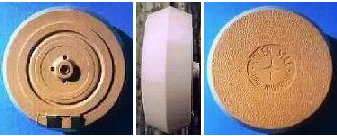 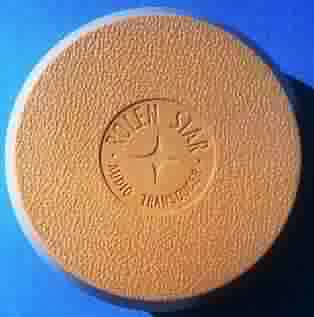 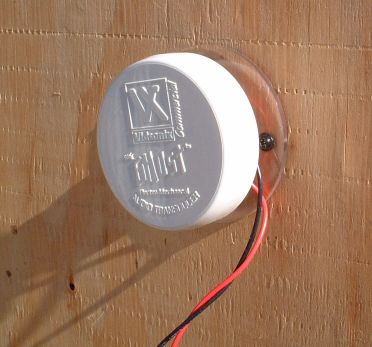 | Bandwidth: 20Hz - 20kHz +/-3dB, full range Maximum Power: 100W RMS Continous Power: 50W RMS Magnet: 2 lb Alcino Ferrite Voice Coil: 1" edgewound aluminum with Ferro Fluid Impedence: 8 ohms Size: 4" dia x 1.75" H Weight: 2.2 lbs PATENT / BREVET : https://www.google.com/patents/US3366749 (Inventeur/Inventor : Hugo Ries, 1964)  |
Autres transducteurs :
- Le capteur de surface ou microphone de contact
Un microphone de contact est un type de microphone conçu pour capter non pas les variations de la pression de l'air comme le fait un microphone acoustique traditionnel, mais les vibrations d'un matériau solide.
Le microphone piézo électrique : Les ondes sonores transmisses sur une surface sur laquelle est posé le microphone piézoélectrique font vibrer les minéraux contenus à l'intérieur (quartz, sels de Rochelle, charbon). La friction entre les particules de ces minéraux crée une tension électrique sur la superficie du piézo, tension qui peut être captée et traduite en signal sonore.
in progress
Les résonateurs (sculptures)(Edit)
(à traduire)
Not all materials make good resonators; it’s a process of trial and error to come up with a handful of good ones out of a wide range of apparent possibilities. Tudor described Rainforest as a piece which “teaches itself,” and here we see him as its first student. I find it surprising that one of the four loudspeaker-objects was plate glass – in a 1995 interview I conducted with Tudor he specifically told me that “Early on ... I avoided glass.” – but then there are theatrical considerations at play here which perhaps allowed a tradeoff between dramatic visual presentation and an ideally resonant speaker-object. (— Tiré de l'article de John Driscoll et Matt Rogalsky, "David Tudor’s Rainforest: An Evolving Exploration of Resonance", issu d'une présentation au symposium “The Art of David Tudor” qui a eu lieu au Getty Research Institute en 2001.)
The creation, design, and construction of the sculptural speakers is also left to each individual composer. The use of specific sculptures will vary greatly from installation to installation based upon:
- who is performing (each composer maintains their own collection of objects)
- the scale and nature of the performance space
- balancing the sonic properties of various materials (metal, plastic, glass, etc.)
- the number of performers
Because of the varying backgrounds of each composer some sculptural speakers may be found objects while others may be more elaborately fabricated sculptures. The simplicity or elaborateness of the sculptural speakers was never dictated in the collaboration and over the years has accommodated a wide range of sculptures.
The repertory of available sculptures increases exponentially as more installations of the work take place. Many have been unique to a particular installation and are retired because of difficulty to transport them due to size or weight. Some objects do not produce the optimum result and are also retired. A number have persisted and became almost “classic” sculptures that appear and re-appear, sometimes growing larger and mutating with time. — (John Driscoll)
Les haut-parleurs instruments(Edit)
(à traduire) — "One of the ideas in my Rainforest series is that loudspeakers should be individuals, they should be instruments. So if you need a hundred of them to fill a hall, each one should have its own individual voice ... After all what is a loudspeaker? At present it’s a reproducing instrument, but my feeling all along has been that you should regard it as a generating instrument ... Why shouldn’t there be a thousand or more ways of building loudspeakers? ... Suppose you build one which only responds to the frequencies between 100 and 200? ... If you put sine waves through it, then you get quite a different sound emerging ... The loudspeaker is transforming what goes into it, instead of reproducing it. — (Tudor, 1972)
(à traduire) — "The work requires the fabrication of special resonating objects and sculptural constructs which serve as one-of-a-kind loudspeakers when transducers are attached to them. The constructed "loudspeakers" function to amplify and produce both additive and subtractive transformations of source sounds such as basic electronic waveforms. In more recent performances the sounds have included a wide selection of prerecorded materials. — (David Dunn, "A History of Electronic Music Pioneers")
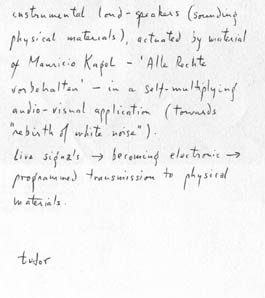 | PRESENTATION DE BANDONEON ! (A COMBINE), NINE EVENINGS, E.A.T. NYC, 1966 [5] INSTRUMENTAL LOUD-SPEAKERS (SOUNDING PHYSICAL MATERIALS), ACTUATED BY MATERIAL OF MAURICIO KAGEL - 'ALLE RECHTE VORBEHALTEN'[6] IN A SELF-MULTIPLYING AUDIO-VISUAL APPLICATION (TOWARDS "REBIRTH OF WHITE NOISE"). LIVE SIGNAL → BECOMING ELECTRONIC → PROGRAMMED TRANSMISSION TO PHYSICAL MATERIALS TUDOR. HAUT-PARLEURS INSTRUMENTS (FAIRE RÉSONNER DES MATÉRIAUX ET DES OBJETS) ACTIONNÉS PAR UN MATÉRIAU ŒUVRE DE MAURICIO KAGEL - "ALLE RECHTE VORBEHALTEN"[7] — SOUS FORME D'UNE APPLICATION AUDIO-VISUELLE AUTO-MULTIPLICATRICE (VERS LA "RENAISSANCE DU BRUIT BLANC") SIGNAL EN DIRECT → DEVIENT ÉLECTRONIQUE → TRANSMISSION VERS DES MATÉRIAUX RÉSONANTS TUDOR. "POUR CETTE ŒUVRE (BANDONEON) TUDOR A SPÉCIALEMENT DÉVELOPPÉ DES HAUT-PARLEURS INSTRUMENTAUX AVEC LESQUELS IL A EXPLOITÉ LES RÉSONANCES SONORES DE MATÉRIAUX ET D'OBJETS. CETTE NOTION DU HAUT-PARLEUR EN TANT QU'INSTRUMENT MUSICAL FÛT LARGEMENT DÉVELOPPÉE DANS SON ŒUVRE REMARQUABLE RAINFOREST DANS LAQUELLE DES FRÉQUENCES ET DES IMPULSIONS SONORES GÉNÉRÉES PAR DES OSCILLATEURS VENAIENT METTRE EN RÉSONANCE DES OBJETS QUI AINSI DEVENAIENT DES HAUT-PARLEURS INSTRUMENTAUX"[8] (GORDON MUMMA, "LIVE ELECTRONIC MUSIC" IN 'THE DEVELOPMENT AND PRACTICE OF ELECTRONIC MUSIC', JON H. APPLETON (ED.), UPPER SADDLE RIVER : PRENTICE HALL (PUB.), 1975, PP. 296-297) |
in progress
Le déroulement d'une performance de Rainforest(Edit)
(à traduire)
There are no coordinated starting points and ending points to the work other than the scheduled durations of the performances. The work relies upon the performers listening to each other and responding in kind. Given the duration of the work it is possible to create large shifting sound characters which evolve over extended periods interspersed with short duration local sound events unique to one object.
Because the work is performed for up to five continuous hours by up to 10 independent performers it is never musically the same performance to performance. Therefore, it is very much an improvisational coordination of the sound materials, but one that has become extremely familiar and ingrained in the performers. Since there is no single point of view the work is never heard the same by any audience member, nor by any of the performers since they are arranged in different parts of the space. This is why performers occasionally walk about testing the sonic balance and density in other parts of the space. — (John Driscoll)
in progress
La participation des auditeurs et la place de l'écoute(Edit)
(à traduire)
Well if [an audience] come to an environmental show like Rainforest, I expect them to enjoy themselves and feel free. If I do a concert performance I hope they are able to listen, ’cause that’s what I do when I perform, I listen to the music. That’s how the performance is made. I listen to it and change it as it goes along. If I weren’t listening it wouldn’t change. [...] I hope that they realize that it’s a human being that’s doing the music. That’s why I think that it’s important to do performances this way, and I can guarantee you that even if I did have a computer involvement, in the sense that it is programming the performance, that I would interfere with it. It is important to me that the audience senses the presence of a live musician. It makes all the difference in the world. — Tudor, David. Interview with Bruce Duffie. Chicago, April 7, 1986. Recording obtained from the interviewer, and transcribed by Matt Rogalsky. http://www.bruceduffie.com/tudor3.html
In Rainforest IV, Tudor also invited the human body back into his music by using interactive sculptures of found objects to encourage audience participation. Rather than frighten listeners with a visual display of aggressive physicality as he had earlier done with Cage, Tudor now engaged their bodies directly in experiencing sound by offering them the possibility of “touching” and sensing objects acting as loudspeakers. Audience members could invent their experiences of the sound by moving around and exploring the shapes presented to them, interacting in this manner as the listeners at the first happening in Black Mountain College had, when they had projected their imagined displays onto the vacant surfaces of Robert Rauschenberg’s white paintings. Tudor’s installation brought to mind as well the contemporaneous work of Robert Morris, whose “sculptures for performing on,” involved the use of “ bodily reactions.” In the spirit of Artaud’s “poésie dans l’éspace,” the sounding objects of Rainforest IV inspired categorical shifts and displacements, for example in how its participants understood the role of their various sense in the aesthetic experience of listening. As Bill Viola exclaimed to David Tudor: “you did teach me (in Rainforest) to hear with my eyes.” — (Tamara Levitz)
David Tudor's stage role consisted of listening intently, shaping the sound created by his own electronics, and thus establishing the long wished for direct bond between his inner ear and the produced tones. David Miller was overwhelmed by the impression this living embodiment of the act of listening: “Without realizing it, I did not take my eyes from David Tudor’s face…and in this way received a remarkable confirmation of the sensuality of an active, engaged intellect. Externally viewed, what was he doing? Sitting quietly, manipulating an elaborate array of controls, his body appeared mostly dormant, the only evident activity being that taking place between the hand and the brain…What might have been interpreted as a purely cerebral process manifested itself throughout as a virtually erotic experience. The old dichotomies between mind and body, intellectual and carnal being were both stated and eliminated in this performance.” — (Tamara Levitz)
The sounds of Rainforest IV, like its objects, tended to forefront the absent human body, which remained for Tudor a site of pain and violence, expressed aurally through intolerable, screeching or bodily noises. M.C. Richards recognized the violence of his electronically produced sounds after attending a performance in October 1966: “I fled after the volume of amplified sound became deafening,” she wrote in her diary, “ I suddenly realized the ‘hard fact’ of David’s disregard for simple human qualities, and his lack of respect for his own ‘ear’ as well as mine and others.” One visitor to the 1976 installation in Minneapolis commented, “It is a loud, cacophonous, continuously changing bombardment of sounds that surround and engulf the listener.” In capturing such an explosive source of sound energy, Tudor realized Antonine Artaud’s aim not only of expressing cruelty, but also of creating a work “in which we feel the whole nervous system burning like an incandescent lamp with vibrations, consonance which invite man to got out with his body in pursuit of this new, strange and radiant Epiphany in the sky.” Linda Fischer described the physical effect as “a condition of inner resonance and rhythms I have known and been unable to articulate…It was something like a confrontation of the physical senses with their non-physical counterparts — an intensity that is so physical it seems I might shatter — these were emotions that I had never felt before, but powerful and elusive and completely real.”
Tudor designed Rainforest in order to signal the violence of not just any absent body, but rather of his own. Rather than transfer his numbed, disassociated senses, bodily functions and desires to inanimate objects a he had earlier done, he now represented and materialized them in the outer concrete reality of electronic circuitry. Following Rauschenberg’s path, he left the outer trace of his productive, spiritual act of inner listening on the stage by symbolizing it in the intricate web of complex electronic gadgetry laid out on the table in front of him, transferring it in this way from the ethereal realm of the imagination into the physical world. In that Tudor almost always decided himself on the source and process of the ultimate sound, the circuitry and electronic gadgetry can be seen to externalize and physically represent the workings of his own mind.
The intense physical exertion required to exhibit his inner ear as an electronic theatrical trace in Rainforest IV caused Tudor to negate further his outer body, which became ever more a mere encasing for inner workings now externalized in circuitry. Tudor symbolized this encasing too with the object of the suitcase, which he carried with him on all his extensive travels in late years, and which contained only electronics (the technological recreation of his inner spiritual ear) and spices (the intellectualized, categorized game plan of his abstracted sense of taste). Having given all his spirituality and wisdom to sound, Tudor was left with a silent body as trampled valise. Perhaps for this reason Rainforest IV has always had such an effect on its listeners. They were not hearing Cage’s “sounds in themselves,” but rather, the direct aural expression of the violent cry of David Tudor’s body. — (Tamara Levitz)
of course modes of attention that depend on being physically part of the work differ from things that use focus and fixation as the primary modes of attention. [...] Decades ago, I lost my ability to sit still and listen to music in a concert hall. It wasn’t the music that died; it was my ability to attend to sound in that way. I can still get completely into a piece of music from the common-practice period via a recording, or by playing it out on the piano. But of course, there is a host of other ways of being involved as a listener without specifying the orthodox version of interactivity, which, as I mentioned, imposes some severe artistic limits. Distracted listening, spatial listening, cocoon listening, touristic listening, visual listening . . . the list could go on anon: All these are attentional forms that involve the listener in different ways with the material. My own introduction to other ways of listening, as we discussed before, was David Tudor’s Rainforest IV. — (Paul DeMarinis, "An Interview with Paul DeMarinis", by Gascia Ouzounian, In Computer Music Journal, 34:4, pp. 10–21, Winter 2010)
| Beaucoup [de solutions] se trouve dans le caractère de l'écoute : si les haut-parleurs sont tout simplement là par eux-mêmes pour pulser du son en conserve ou s'ils "parlent" vraiment pour vous, et ceci, c'est quelque chose que seulement un musicien qui écoute peut vous apporter. Si vous avez un musicien qui joue en direct un morceau dans un espace, et qu'il est à l'écoute du son, et qui sait quand et comment faire une modification ou une modulation pour animer et rendre vivant la situation d'écoute dans laquelle vous vous trouvez avec lui, alors vous sentez que quelque chose se passe en direct. Si vous n'avez pas cela, alors vous devez accepter le fait que c'est comme aller au cinéma. Les choses ne vont pas progresser si la musique électronique reste à ce niveau de diffusion de choses "pré-conçues". [9] — David Tudor, from An Interview with David Tudor by Teddy Hultberg in Dusseldorf, May 17-18, 1988, http://davidtudor.org/Articles/hultberg.html |
Les enjeux musicaux de Rainforest(Edit)
Plusieurs distinctions sont importantes à éclairer. Elles peuvent amener à des caractéristiques liées à :
- l'œuvre élargie (ou, ce que je cite souvent, la musique étendue ou « en plein air »), immergée dans des contextes multiples, parfois ubiquitaires, à partir de processus singuliers spécifiquement réalisés à cet effet, qui en questionnent à la fois le statut et la perception (la réception active) ;
- l'œuvre flux (constituée de matériaux non reproductibles, continuellement renouvelée, et dont il faut faire à chaque fois l'expérience)
- l'œuvre circuit (en ce qu'elle circule en permanence, ou met en circuit (en forme?) les flux précédemment évoqués)
Au passage, et nous allons le voir, il me semble intéressant de souligner aussi que ce type d'œuvres pose un problème récurrent concernant leur archivage, c'est-à-dire leur conservation et leur reproductibilité.
Ces œuvres peuvent assembler momentanément des éléments en flux, en créer une documentation et une présentation, les stocker (techniquement, si nous parlons des procédés numériques, dans des "buffers", des réservoirs de stockage dynamique, voire, dans le cas de Rainforest, des enregistrements sonores momentanés captant des moments de l'œuvre), mais en fait cela fuit toujours. Si cela fuit, puisque les flux sont continuellement en train de se dérouler et de nous échapper, nous ne pouvons archiver.
(à traduire) — David Tudor rarely theorized about his work in live electronics, preferring instead to focus on the invention and performance processes themselves as the media of his artistic ideas. [...] Deleuze, like Tudor, does not separate the technological and human components of a given constellation, but understands them to be “composed” into materially immanent assemblages or complexes of “images” (understood not just visually, but multi-sensorially). Gell, in turn, offers a vocabulary of “distributedness” of both art object and artistic agency that helps account for the shifting dynamics of complex, immanent performance situations. [...] The much-noted emphasis of this music on process over product and the sound-ecology models that often underlie the artists’ conception of these works (from Tudor’s Rainforest to David Dunn’s environmental music projects and speculations on music as interspecies communication) resonate closely with Deleuze’s idea of the cinema image as a dynamic manifold of technical, material, and vital components. [...] Deleuze has in mind the range of cinematic narratives that involve irrational narrative connections, undecidable multiplications of narrative versions, magical causations, time-loops and mental travel, and so on. I relate these two modes of temporal representation to the two basic technical modes that Tudor employed in his live electronic works: 1) Those works that treat the electronic environment as a space of “transduced objects” in which oscillation, echoing, and spatial focalizing and displacement are key processes (from Fluorescent Sound to Rainforest, originally a dance piece for Merce Cunningham and later a sculptural sound environment); 2) and late works such as the Neural Syntheses that enfold the specialized relations of the earlier works back into the structure of the electronic components for generating the sound environment, constituting a kind of technosonic brain or “neural network.” In these works, performance activates and expresses as sound-events some contingent sample of the network’s virtual connections, proximities, and distances. — (Tyrus Miller, Transduced Objects and Spiritual Automata: Dimensions of Experience in David Tudor’s Live Electronics)
"I started with the idea that... sound could be obtained from sculptural material or actually from anything through reflections. But the thing that is turning my idea about how to form the piece ‘inside-out’, because, you see, I was starting from materials, and now I’m already working with waves which don’t exist” (Interview with Larry Austin, 3 April 1989).
- Les enjeux de l'utilisation des "feedback"
(à traduire) — In many pieces based on feedback systems, most notably in David Tudor's electronic pieces, there arises a situation in which the performer is improvising within (or sometimes against) an indeterminate context. A complex web of interconnections is constructed, leading to unpredictable and chaotic sonic results. The composer/performer then interacts with the system, attempting (with highly-varying degrees of success) to "guide" the system in a particular direction. Christopher Burns and Matthew Burtner describe this peculiar fusion of composition and improvisation in their article "Recursive Audio Systems":
"Once the system is established, improvisation becomes an essential mode of compositional exploration. The unusual parametrizations of feedback systems, including their high degree of dependence upon the current state and contents of the system, necessitate an investigative approach." (Christopher Burns and Matthew Burtner, "Recursive Audio Systems," Leonardo Music Journal, Vol. 13 (2003): 73.)
As a pianist, David Tudor simultaneously embodied two polar extremes: his performance technique demanded a precisely deterministic causal relationship between physical action and sonic result, while his chosen genre of indeterminism and chance strove above all to remove intentionality and control from the music. In his own works, however, these two "Tudors" are at last comfortably reconciled. Deliberate actions yield unpredictable results; virtuosity and failure can coexist. While Tudor's live electronic performances were frequently described as dazzling displays of virtuosity, "his physical contact with the electronic components resulted in a spectrum of sound possibilities, all a step removed from the physical impulse that had caused them." (Tamara Levitz, "David Tudor's Corporeal Imagination," Leonardo Music Journal, Vol. 14 (2004): 61) Built in to the architecture of feedback is a distancing—a failure of communication—that occurs between the composer, the performer, and the instrument. For Tudor, this "aesthetic of failure" (Kim Cascone, "The Aesthetics of Failure," Computer Music Journal, Vol. 24 (2000): 12-18.) results in a new level of interaction that is absent in modernism, chance, and improvisation alike. Though he remained a loyal Cage supporter to the end, hedelicately admits as much himself in his 1972 article "From Piano to Electronics":
"I wasn't interested in playing a game or dealing with a set of finite circumstances but rather in the fact that the world was completely open, and through a set of finite circumstances one could be led into something completely open. This was always uppermost in Cage's works, but a lot of the pieces I was getting seemed to be more attracted by the idea of structures rather than by the possibilities these open up." (David Tudor, "From Piano to Electronics," Music and Musicians (August 1972): 24.)
Though none of the Rainforest installations incorporate feedback explicitly (each "speaker" is simply fed a looped recording of the participant's choosing), the project clearly reflects an early interest in pseudo-biological acoustical ecosystems. To a certain degree, of course, the resonance of a particular object in Rainforest will be affected by the resonances of others, and this does induce a more subtle element of feedback into the work. By Tudor's own admission, however, the disembodied structure of the installation did not allow for a significant feedback effect:
"I did experiment several times .... where I did get feedback into the system. But that isn't so interesting when the output is so small; it gets very interesting when they're larger." (David Tudor, "An Interview with David Tudor by John David Fulleman," EMF, http://www.emf.org/tudor/Articles/fullemann.html )
As effective and influential as Rainforest turned out to be, Tudor expresses some dissatisfaction with the arbitrariness and occasional inappropriateness of the source materials. Tudor somewhat sarcastically hypothesized that, "You can give a tango party and play tango through all of these instruments and one after the other and it would be glorious, I can guarantee you. But it is not going to be my piece." (David Tudor, "Interview with David Tudor," EMF, http://www.emf.org/tudor/Articles/rogalsky_inter1.html ). His subsequent compositional efforts attempted to address this perceived shortcoming while retaining the complex networked structures of the Rainforest series. The answer came in 1972 when Tudor discovered that, when compiled correctly (or incorrectly as the case may be), electrical components such as mixing boards, effects pedals, and equalizers will spontaneously create sound without the aid of any external input. Tudor describes the process of the discovery in an interview with Teddy Hultberg:
"Rather than think of tone generators or recordings of natural sounds etc., I experimented with principles of amplification, trying to make amplifiers oscillate in an absolutely unpredictable manner. In the end, it turned out that I didn't even need any amplifiers because most electronic equipment uses the principle of amplification. You need filters,modulators and mixing equipment which have gain stages. By piling these components up, I was able to work without any sound generators and I made several pieces in that manner."
The first piece that Tudor realized with this newly discovered technique of "noinput feedback" was called Untitled (1972) and was composed to accompany a reading by John Cage of his Mesostics re Merce Cunningham. — Weisert, Lee. IN/OUT/IN : Feedback Systems in Music. Dissertation Doctor or Music, Field of Music Composition. Northwestern University Evanston. 2010. http://leeweisert.com/inoutin.pdf )
"I want to find ways of discovering something you don't know at the time that you improvise.... The first way is to play an instrument over which you have no control, or less control than usual" (David Tudor, In Richard Kostelanetz, ed., "Conversing with Cage" (New York, NY: Limelight, 1987).([the instability of the feedback system makes it an equal partner in the improvisational process]) (quoted in Christopher Burns and Matthew Burtner, RECURSIVE AUDIO SYSTEMS: ACOUSTIC FEEDBACK IN COMPOSITION)
- Le rapport à l'espace
| (à traduire) — "Little real work has been done using spatial positioning as a compositional technique. The science of acoustics has not often been applied to isolating sound phenomena to specific positions in space. There can be a world of musical compositions utilizing the distribution of localized sonic events in space rather than time: sound designs in physical dimensions and musical architectures, both static and dynamic. The exploration of these musical worlds is dependent on the development of tools and techniques for localizing vibration in air." — (Tudor research proposal, circa 1970 ) — This idea led Tudor to experiment with highly directional rotating loudspeakers. These devices would allow the performers to interact with each other in a more complex manner and would enable them to work directly with the acoustic space, pointing their sounds directly at parts of the space or at other sounds. Tudor's group, Composers Inside Electronics, experimented a great deal with these designs. Tudor's "Pepsi pieces" were also a result of his keen interest in spatial positioning. These were a group of pieces composed for the Pepsi Pavilion at the 1970 Expo in Osaka. Tudor had a large dome constructed within the pavilion to hold thirty-seven loudspeakers that would enable him to place his sounds in virtually any part of the pavilion. Custom components were designed to switch signals, automatically and manually, in various ways to the different speakers. The Pepsi pieces were all composed specifically for this speaker set-up and many were never performed in that way again. — (D'Arcy Philip Gray, "The Art of Impossible") |
(à traduire) — I argue that the “experimental sound ideal” had as its banner an aesthetic of liberation and that such liberation was won by control over the musical parameters through procedures of quantification. [...] Letters to Tudor from Cage, Feldman, Brown, and others indicate that the undefined relation between composer and sounding result in the indeterminate works was nonetheless accompanied by aesthetic criteria that would allow a “correct” performance. {...] the experimental sound ideal entails procedures that enable both performative uniqueness and a kind of sounding objectivity that is premised on the erasure of subjective agency. Here I argue that these procedures allow certain stylistic features to emerge and that these features define the governing sound ideal. Tudor’s performance procedures allow him not simply to avoid traditional types of melodic, harmonic, and formal constructions but even further to realize an alternate type of musical design. The papers clearly show that Tudor approached his realizations of the indeterminate works by objectifying the musical parameters with quantifying procedures of measurement and lists. Thus, musical rhythm becomes, metaphorically, events in space, and sound quality becomes a performance action. [...] I begin with Tudor’s sense of an enveloping as opposed to an “out front” sense of temporal space. This differing temporal sense is linked to a “non-gridded” articulation of time. Traditional music notation produces an implicit temporal grid that contextualizes the temporal progress of musical sound. Without such an implicit grid, events in musical time occupy a relational temporal space into which listeners may place themselves. The resulting overall sense is one in which events “float” and articulate spans of time. — (Judy Lochhead, Controlling Liberation: David Tudor and the “Experimental” Sound Ideal)
In his electro-acoustic sound environment, Rainforest IV, unexpected gong sounds emanate from the oil drum and chirps from inside the suspended barrel. Tudor effects these sound transformations by physically modifying his instrument, by experimenting with resonance, electronic feedback, amplification, and filters, and by distributing the acoustically and electronically modified sounds through the performance space. The physical space, which can mean the performance site, the physical object (in which sound resonates), the instrument or environment generating the source sounds, and the electronic configuration, becomes the catalyst for the composer’s exploration and for the listener’s perception of sound as malleable, sculptural material. {...} Tudor’s electronic music thus concerns itself less with sounds as sounds, and more with the complex relation between sounds and the physical spaces in which they vibrate. This situation raises intriguing questions about our point of view as listeners. Is there a particular vantage from which we hear the sound, or has the vantage become the entire (performance) space? How do we, as listeners, connect the sounds with what might be called their “source space”? Or do we? To what extent does this preoccupation with space, and the dependence of sound on physical spaces, present an important difference between Tudor and his longtime collaborator on indeterminate piano and taped pieces, John Cage? In Tudor’s live electronics of the 1970s and 80s, the performing musicians respond in real time to unpredictable feedback loops amplified by the acoustics of the performance site and fed by the musicians through multiple channels in a custom designed sound system. Sometimes pre-recorded sound provides the input signals. Other times, the chain of electronic components produces the signals. Tudor conceived of Microphone (1973), for example, as an “interface between a performer and the feedback of his sound.” For his environment installed at the 1970 World’s Exposition in Osaka, performers sent feedback of directional microphones into the space of the Pepsi Pavilion, where loudspeakers arranged in spatial patterns controlled the incidence and duration of the resulting signals. Modulators, designed by Gordon Mumma, were placed into the signal paths in order to vary the musical content of the feedback signals. If sound moved quickly enough from speaker to speaker, Tudor mused, there would come a point when listeners could no longer distinguish the source sound from the feedback it generated. — (Nancy Perloff, Hearing Spaces: David Tudor’s Collaboration on Sea Tails)
- Les enjeux de la "continuité"
(à traduire) — “All of a sudden there was a different way of looking at musical continuity, having to do with what Artaud called the affective athleticism… It was a real breakthrough for me, because my musical consciousness in the meantime had changed completely… I had to put my mind in a state of non-continuity – not remembering – so that each moment is alive” (Tudor , quoted in Holzaepfel 2002, p. 171).). (Holzaepfel, J. (2002). “Cage and Tudor” in D. Nicholls (ed.), The Cambridge Companion to John Cage. Cambridge: CUP, pp. 169-85.)
The “surround-space” of possibilities that Tudor describes is perhaps the greatest tool of differentiation between pre- and post-1945 approaches, yet it also stands as a potent field of internal tensions and re-workings of musical structure across the board of post-war compositional history. — Danae Stefanou and Pavlos Antoniadis, "Inter-Structures: Rethinking Continuity in Post-1945 Piano Repertoire", In journal of interdisciplinary music studies, spring/fall 2009, volume 3, issue 1&2, art. #0931205, pp. 77-93)
Rainforest IV (Stockholm Performance) (1980)
Bibliographie & Références Urls(Edit)
- Adams, John D. S. & Donovan, Erin. Still Listening: Pauline Oliveros Reflects on the Life and Music of David Tudor. Musicworks 70 (Spring 1998): 34–37.
- Adams, John D. S. Giant Oscillations: The Birth of Toneburst. Musicworks 69 (1997): 14–17. [online] http://davidtudor.org/Articles/jdsa_giant.html
- Barker-Mill, Adam. David Tudor's Sound Table. Musicworks 73 (1999): 24–25.
- Beal, Amy. Ambassador of the American Avant-Garde: David Tudor in West Germany, 1954-1972. Presented at the Getty Research Institute Symposium, “The Art of David Tudor,” in 2001. http://www.getty.edu/research/exhibitions_events/events/david_tudor_symposium/pdf/beal.pdf
- Beal, Amy. David Tudor in Darmstadt. Contemporary Music Review 26, no. 1 (2007): 77–88. http://music.ucsc.edu/sites/default/files/TudorInDarmstadt.pdf
- Beal, Amy. A Short Stop Along the Way : Each-Thingness and Music for Merce. New World Records. "Music for Merce". 2010. http://music.ucsc.edu/sites/default/files/MCDC.pdf
- Behrman, David. Private Person, Public Figure: David Tudor in the '60s and '70s. Musicworks 71 (1998): 44–46.
- Behrman, David. What Indeterminate Notation Determines. In Perspectives on Notation and Performance. New York: W. W. Norton, 1976 [originally published 1965, in Perspectives of New Music, Vol. 3, No. 2 (Spring-Summer 1965), pp. 58-73], 74–89. http://digitalmusics.dartmouth.edu:801/~larry/music%20104%20spring%202011/readings/Behrman.pdf
- Burns, Christopher. Emergent Behavior from Idiosyncratic Feedback Networks. Proceedings, International Computer Music Conference 2003. San Francisco: International Computer Music Association. http://sfsound.org/~cburns/writings/burns-icmc2003.pdf http://nagasm.org/ASL/icmc2003/closed/CR1089.PDF http://sfsound.org/~cburns/publications-research.html
- Burns, Christopher & Burtner, Matthew. Recursive Audio Systems : Acoustic Feedback in Composition. Leonardo Electronic Almanach, Vol. 12, issue 2 Feb. 2004. https://ccrma.stanford.edu/~mburtner/files/BurtnerBurns_LEA.pdf
- Burns, Christopher. Designing for Emergent Behavior: a John Cage realization. Ann Arbor, MI: MPublishing, University of Michigan Library. 2004. http://sfsound.org/~cburns/writings/burns-icmc2004.pdf
- Cameron, Laura & Rogalsky, Matt. Conserving Rainforest 4 : aural geographies and ephemeralities. In Social and Cultural Geography, Vol.7. No.6, December 2006. pp. 909-926. http://www.tandfonline.com/doi/abs/10.1080/14649360601055847#.UZeH_YXCM4A
- Chadabe, Joel. Electric Sound: The Past and Promise of Electronic Music. Upper Saddle River, New Jersey: Prentice Hall, 1997. http://www.arts.rpi.edu/~rolnick/classes/MSMusic/Chadabe%20The%20Great%20Opening%20Up.pdf
- Clarkson, Austin. A Creative Collaboration: Stefan Wolpe's and David Tudor's Battle Piece. Musicworks 73 (1999): 32–35.
- Clarkson, Austin. Composing the Performer: David Tudor Remembers Stefan Wolpe. Musicworks 73 (1999): 26–32.
- Clarkson, Austin. Tudor's Apprenticeship: The Years with Irma and Stefan Wolpe. Leonardo Music Journal, Vol. 14, pp. 5-10. 2004. http://rd.slavepianos.org/ut/rttcc.historical/text/Clarkson2004a.pdf
- Collins, Nicolas. Composers of Electronics: Music after David Tudor. Leonardo Music Journal, Volume 14, 2004. pp. IV, 1-3. http://www.jaimeoliver.pe/courses/ci/pdf/collins-2004.pdf
- Composers Inside Electronics. Window on the Work: David Tudor's Rainforest IV. Realized by Composers Inside Electronics. New York: Lincoln Center Institute, 1998. Published in conjunction with the Lincoln Center installation in July 1998.
- Composers Inside Electronics. Music After David Tudor. Leonardo Music Journal 14 (2004). http://www.leonardo.info/isast/journal/toclmj14.html
- Craig, Jordan. A Sound Designer's Car Boot Sale - Composition and Performance Software for Plastic Toys. Masters Thesis, Master of Science (Sound Design), Edinburgh College of Art, The University of Edinburgh. 2011. http://www.academia.edu/2181291/A_Sound_Designers_Car_Boot_Sale_Composition_And_Performance_Software_For_Plastic_Toys_Masters_Thesis_
- Cross, Lowell. Audio/Video/Laser. Source 4, no. 2 (1970): 26–36. (Online edition, 2005). First published in SOURCE, music of the avant garde, issue no. 8 (1970), pp. 26–36. revised and updated version copyright © 2005 by Lowell Cross. http://www.lowellcross.com/articles/avl/
- Cross, Lowell. Musica Instrumentalis, Video II (B), Video II ©, Video II (L). First published in SOURCE, music of the avant garde, issue no. 9 (1971), pp. 3–10. revised and updated version copyright © 2005 by Lowell Cross. http://www.lowellcross.com/articles/musica/
- Crow, Thomas. Modern Art in the Common Culture. New Haven, Connecticut: Yale University Press, 1996.
- Crow, Thomas. The Rise of the Sixties: American and European Art in the Era of Dissent, 1955–1969. London: George Weidenfeld & Nicolson, 1996.
- Driscoll, John. Electronics & Cooking (In memoriam David Tudor). MusikTexte 69/70 (April 1997), 78–79.
- Driscoll, John & Rogalsky, Matt. David Tudor’s Rainforest: An Evolving Exploration of Resonance. Leonardo Music Journal 14 (2004), 25–30. And also : Presented at the Getty Research Institute Symposium, “The Art of David Tudor,” in 2001. http://www.getty.edu/research/exhibitions_events/events/david_tudor_symposium/pdf/driscollrogalsky.pdf
- Duckworth, William. Talking Music: Conversations with John Cage, Philip Glass, Laurie Anderson, and Five Generations of American Experimental Composers. New York: Da Capo Press, 1999.
- Dunn, David. A History of Electronic Music Pioneers. In "Eigenwelt der Apparatewelt: Pioneers of Electronic Art" catalog, Ars Electronica 1992, Linz, Austria. http://www.davidddunn.com/~david/writings/pioneers.pdf
- Emmerson, Simon. Living Electronic Music. Ashgate eBook. 2007. http://www.dmu.uem.br/aulas/laboratorio/Emmerson_LivingElectronicMusic.pdf
- Experiments in Art and Technology, Pavilion. ed. Billy Klüver, Julie Martin, and Barbara Rose. New York: E. P. Dutton, 1972.
- Feisst, Sabine M. John Cage and Improvisation – An Unresolved Relationship. Musical Improvisation: Art, Education and Society, ed. Gabriel Solis and Bruno Nettl (Chicago: University of Illinois Press, 2009), 38-51. http://artsites.ucsc.edu/faculty/abeal/4classes/FeisstCageImp.doc
- Frank, Peter. New York Fluxus. In Rene Block, New York, downtown Manhattan, SoHo: Ausstellungen, Theater, Musik, performance, video, film, 150–179. Berlin: Akademie der Künste der DDR, 1976.
- Freund, David. David Tudor: Four Davis Concerts. Source 1, no. 2 (1967): 70–75.
- Gray, D’Arcy Philip. The Art of the Impossible. Musicworks 69 (1997): 18–21. http://davidtudor.org/Articles/dpg_impos.html
- Gray, D’Arcy Philip. David Tudor in the Late 1980s: Understanding a Secret Voice. Leonardo Music Journal 14, 41–47. 2004.
- Gresham-Lancaster, Scot. The Aesthetics and History of the Hub : The Effects of Changing Technology on Network Computer Music. Leonardo Music Journal, Vol. 8, pp. 39-44. 1998. http://www.skolska28.cz/files/100505234237.pdf
- Harris, Mary Emma. The Arts at Black Mountain College. Cambridge, Massachusetts: MIT Press, 1987.
- Harrison, July. Experiments in Art and Technology (Pepsi Pavilion). ISSA Review, Stevens Institute of Technology, 2004. http://www.julie-harrison.com/writing_+_press_files/JulieHarrison_Art%26Tech.pdf
- Hilberg, Frank. David Tudors Konzept des Elektrifizierten Klaviers und sein Interpretation von John Cages Variations II (1961). In Stefan Fricke, ed., Fragmen: Beiträge, Meinungen und Analysen zur neuen Musik 13 (1996): 3–41.
- Hilberg, Frank. Die Elektronische Poesie Des David Tudor (The Electronic Poetry of David Tudor). Neue Zeitschrift Für Musik 157, no. 6 (1996): 40–43.
- Historisches Archiv der Köln. Intermedial, Kontrovers, Experimentell: Das Atelier Mary Bauermeister in Köln 1960-1962. (Intermedial, Controversial, Experimental: Mary Bauermeister's Studio in Cologne, 1960–1962). Cologne: Emons, 1993.
- Holzaepfel, John. Der Tudor Faktor/The Tudor Factor. John Cage — Anarchic Harmony: Ein Festival Zum 80. Geburtstag, 43–56. Mainz, Germany: Schott, 1992.
- Holzaepfel, John. David Tudor and the Performance of American Experimental Music, 1950–1959. Ph.D. Dissertation. City University of New York, 1994.
- Holzaepfel, John. Reminiscences of a Twentieth-Century Pianist: An Interview with David Tudor. The Musical Quarterly, 1994, Vol. 78, No. 3. (1 March 1994), pp. 626-636. http://mq.oxfordjournals.org/content/78/3/626
- Holzaepfel, John. The Roles of David Tudor in the Early Repertory of the Merce Cunningham Dance Company. Choreography and Dance—An International Journal 4, no. 3 (1997): 45–49.
- Holzaepfel, John. David Tudor, John Cage, and Comparative Indeterminacy. Presented at the Getty Research Institute Symposium "The Art of David Tudor", 2001. (Short version of "Cage and Tudor", 2002). https://www.getty.edu/research/exhibitions_events/events/david_tudor_symposium/pdf/holzaepfel.pdf
- Holzaepfel, John. Cage and Tudor. In David Nicholls, ed., The Cambridge Companion to John Cage. Cambridge: Cambridge University Press, 2002. pp. 169-185.
- Hotte, Hans. David Tudor & John Cage - Rainforest II / Mureau. New World Records. 2007. http://www.newworldrecords.org/linernotes/80540.pdf
- Iddon, Martin. John Cage and David Tudor - Correspondence on Interpretation and Performance. Cambridge ; New York : Cambridge University Press. 2013. ISBN-10: 1107014328 | ISBN-13: 9781107014329.
- Johnson, Steven. The New York Schools of Music and Visual Arts: John Cage, Morton Feldman, Edgard Varèse, Willem de Kooning, Jasper Johns, Robert Rauschenberg. New York: Routledge, 2002.
- Kahn, Douglas. The Latest: Fluxus and Music. In Janet Jenkins, ed., In the Spirit of Fluxus: Published on the Occasion of the Exhibition "In the Spirit of Fluxus." Organized by Elizabeth Armstrong and Joan Rothfuss. Minneapolis: Walker Art Center, 1993.
- Kahn, Douglas. Noise Water Meat: A History of Sound in the Arts. Cambridge, Massachusetts: MIT Press, 1999.
- Kahn, Douglas. David Tudor and the Sound of Anthroposophy. Presented at the Getty Research Institute Symposium, “The Art of David Tudor,” in 2001. http://www.getty.edu/research/exhibitions_events/events/david_tudor_symposium/pdf/kahn.pdf
- Kostelanetz, Richard, ed. Merce Cunningham: Dancing in Space and Time. Chicago: A Capella Books, 1992.
- Kotz, Liz. Disintegrated Circuits: Rethinking the Score in the Postwar ‘Aesthetics of Indeterminacy’ . Presented at the Getty Research Institute Symposium, “The Art of David Tudor,” in 2001. http://www.getty.edu/research/exhibitions_events/events/david_tudor_symposium/pdf/kotz.pdf
- Kuivila, Ron & Behrman, David. Composing with Shifting Sand: A Conversation between Ron Kuivila and David Behrman on Electronic Music and the Ephemerality of Technology. Leonardo Music Journal, Vol. 8, Ghosts and Monsters: Technology and Personality in Contemporary Music. (1998), pp. 13-16. http://soundartarchive.net/articles/Kuivila-1998-Composing%20with%20Shifting%20Sand.pdf
- Kuivila, Ron. Open Sources Circuits: Words, Circuits, and the Notation/Realization Relation in the Music of David Tudor. Presented at the Getty Research Institute Symposium "The Art of David Tudor", 2001. http://getty.art.museum/research/exhibitions_events/events/david_tudor_symposium/pdf/kuivila.pdf
- Leonardo Music Journal 14 (2004). Special issue: Composers Inside Electronics: Music After David Tudor. (Table of Contents)
- Levitz, Tamara. David Tudor’s Corporeal Imagination. Presented at the Getty Research Institute Symposium "The Art of David Tudor", 2001. http://www.getty.edu/research/exhibitions_events/events/david_tudor_symposium/pdf/levitz.pdf
- Lochhead, Judy. Controlling Liberation: David Tudor and the “Experimental” Sound Ideal. Presented at the Getty Research Institute Symposium "The Art of David Tudor", 2001. http://www.getty.edu/research/exhibitions_events/events/david_tudor_symposium/pdf/lochhead.pdf
- Lorway, Norah. Stirring Up Pea Stew : A Networked Feedback Structure for Live Coding. The International Conference on Live Interfaces (ICLI) 2012, ICSRiM Interdisciplinary Centre for Scientific Research in Music, School of Music, University of Leeds, UK. http://www.academia.edu/1951771/Stirring_Up_Pea_Stew_A_networked_feedback_structure_for_Live_Coding
- Menezes, Flo. La voie du syncrétisme : sur la musique électroacoustique au Brésil. Circuit : musiques contemporaines, vol. 17, n° 2, 2007, p. 55-64. http://id.erudit.org/iderudit/016839ar http://www.erudit.org/revue/circuit/2007/v17/n2/016839ar.pdf
- Miller, Tyrus. Transduced Objects and Spiritual Automata: Dimensions of Experience in David Tudor’s Live Electronics. Presented at the Getty Research Institute Symposium "The Art of David Tudor", 2001. http://www.getty.edu/research/exhibitions_events/events/david_tudor_symposium/pdf/miller.pdf
- Miller, Tyrus. Singular Examples: Artistic Politics and the Neo-Avant-Garde. Northwestern University Press. pp. 115-138. 2009. http://www.academia.edu/Documents/in/The_Art_of_David_Tudor
- Mingei International Museum. Art that Soars: Kites and Tails by Jackie Matisse. La Jolla, California: Mingei International, 2000.
- Mumma, Gordon. Live-Electronic Music. In Jon H. Appleton and Ronald C Pereara, ed., The Development and Practice of Electronic Music. Englewood Cliffs, New Jersey: Prentice-Hall, 1975.
- Mumma, Gordon. Creative Aspects of Live Electronic Music Technology. Audio Engineering Society, Papers of 33rd National Convention, NY 1967 Oct. http://brainwashed.com/mumma/creative.htm
- Mumma, Gordon. Electronic Music for the Merce Cunningham Dance Company. Choreography and Dance 4, no. 3 (1997): 51–58.
- MusikTexte: Zeitschrift Für Neue Musik 69/70 (April 1997). Special focus on David Tudor, with new and previously published texts by John Cage, Merce Cunningham, Ron Kuivila, Hans Otte, Daniel Charles, and others.
- Neubert, David. Electronic Bowed String Works: Some Observations on Trends and Developments in the Instrumental/Electronic Medium. Perspectives of New Music, Vol. 21, No. 1/2 (Autumn, 1982 - Summer, 1983), pp. 540-566. http://xa.yimg.com/kq/groups/25036133/1714796577/name/Electronic+Bowed+String+Works.pdf
- Nyman, Michael. Experimental Music: Cage and Beyond. Cambridge: Cambridge University Press, 1999.
- O'Connell, Brendan Christopher. Electronic Friends: David Tudor and Live Electronic Music. (2008). Honors Theses - All. Paper 124. Wesleyan University, Middletown, CT. http://wesscholar.wesleyan.edu/etd_hon_theses/124
- O'Connell, Brendan Christopher. Tudor Electronics. (Thesis addendum). [online]. 2008. https://sites.google.com/site/futureecircuits/david-tudor-electronics
- Ouzounian, Garcia. An Interview with Paul DeMarinis. Computer Music Journal, Volume 34 Issue 4, Winter 2010. pp. 10-21. http://pure.qub.ac.uk/portal/files/772764/Ouzounian%20Interview%20Paul%20DeMarinis.pdf
- Oliveros, Pauline. Reverberations : Eight Decades. Jefferson Journal of Science and Culture, Issue 2. July 2012. pp. 41-54. http://www.jeffersonjournal.org/index.php/journal/article/download/12/9
- Perloff, Nancy. The Eye and the Ear: New Directions in Twentieth-Century Musical Notation. Exhibition brochure. Los Angeles: Getty Research Institute, 1995.
- Perloff, Nancy. Hearing Spaces: David Tudor's Collaboration on Sea Tails. Leonardo Music Journal 14 (2004): 31–39. And also : Presented at the Getty Research Institute Symposium "The Art of David Tudor", 2001. http://www.getty.edu/research/exhibitions_events/events/david_tudor_symposium/pdf/perloff.pdf
- Pigott, John. Vibration, Volts and Sonic Art: A practice and theory of electromechanical sound. Proceedings of the International Conference on New Interfaces for Musical Expression, 30 May - 1 June 2011, Oslo, Norway. http://www.nime.org/proceedings/2011/nime2011_084.pdf
- Pritchett, James. From Choice to Chance: John Cage's Concerto for Prepared Piano. Perspectives on New Music 26 (1988): 50–81.
- Pritchett, James. The Music of John Cage. Cambridge: Cambridge University Press, 1993.
- Pritchett, James. David Tudor’s Realization of John Cage’s Variations II. [online, 2000]. Available from: http://www.rosewhitemusic.com/cage/texts/Var2.html . And also : Presented at the Getty Research Institute Symposium "The Art of David Tudor", 2001. http://www.getty.edu/research/exhibitions_events/events/david_tudor_symposium/pdf/pritchett.pdf
- Pritchett, James .David Tudor as Composer/Performer in Cage’s Variations II. Leonardo Music Journal, 14 (2004), 11–16.
- Richards, John. 32kg: Performances Systems for a Post-Digital Age. In Proceedings of the 2006 Conference on New Interfaces for Musical Expression (NIME-06). Paris, France: 283-287. http://www.mti.dmu.ac.uk/~jrich/docs/post-dig.pdf
- Rogalsky, Matthew R. Creation and Conservation of Live Electronic Music Practice in the Merce Cunningham Dance Company. Ph.D. Dissertation, Wesleyan University, 1995.
- Rogalsky, Matthew R. David Tudor's Virtual Focus. Musicworks 73 (1999): 20–23.
- Rogalsky, Matthew R. Idea and community : the growth of David Tudor's Rainforest, 1965-2006. Thesis (Ph.D.) — City University (London, England), 2006.
- Rogalsky, Matthew R. Nature as an Organising Principle: Approaches to chance and the natural in the work of John Cage, David Tudor and Alvin Lucier. Organised Sound 15 (2) (2010), 133–136.
- Rogalsky, Matthew R. The Art of David Tudor 1963–1992. New World Records the Recorded Anthology of American Music. 2013. http://www.newworldrecords.org/uploads/filenzqVz.pdf
- Rønningsgrind, Guro. Meaning, Presence, Process - The Aesthetic Challenge of John Cage’s Musicircus. Thesis Norwegian University of Science and Technology, Faculty of Humanities, Department of Music. 2012. http://ntnu.diva-portal.org/smash/get/diva2:517562/FULLTEXT01
- Sanfilippo, Dario & Valle, Andrea. Towards a Typology of Feedback Systems. ICMC2012, "Non-Cochlear Sound, Ljubljana, 9-14 Sept. 2012. http://quod.lib.umich.edu/cgi/p/pod/dod-idx/towards-a-typology-of-feedback-systems.pdf?c=icmc;idno=bbp2372.2012.006
- Schonberg, Harold C. The Far-Out Pianist. Harper's Magazine (1960): 49–54.
- Snyder, Ellsworth. John Cage Discusses Fluxus (interview). Visible Language 26 (1992–1993): 59–68.
- Stefanou, Danae & Antoniadis, Pavlos. Inter-Structures : Rethinking Continuity in Post-1945 Piano Repertoire. Journal of Interdisciplinary Music Studies, Spring/Fall 2009, Vol.3, Issue 1&2, pp. 77-93. http://users.auth.gr/~dstefano/Stefanou_JIMS_0932105.pdf
- Stiles, Kristin. David Tudor - Alive, Free, and Without Need of Culture. Presented at the Getty Research Institute Symposium "The Art of David Tudor", 2001. http://www.getty.edu/research/exhibitions_events/events/david_tudor_symposium/pdf/stiles.pdf
- David Tudor Symposium (2001), The Art of David Tudor: Indeterminacy and Performance in Postwar Culture, May 17–19, 2001. http://www.getty.edu/research/exhibitions_events/events/david_tudor_symposium/index.html
- Svonar, Richard. A History Of Spatial Music - Historical Antecedents: from Renaissance Antiphony To Strings In The Wings. In eContact 7.4 "Multichannel Diffusion". Concordia University Montreal, Canadian Electroacoustic Community. 2004. [online]. http://cec.sonus.ca/econtact/7_4/zvonar_spatialmusic.html
- Tomasulo, Andrew. Music for a Variety of Difficult Situations. Thesis, Master of Arts in Electro-Acoustic Music, Dartmouth College, Hanover, New Hampshire. 2001. http://andrewtomasulo.com/art/mfvds/ref/mfvds.pdf
- Tudor, David. Program notes for Bandoneon !. In 9 Evenings of Theatre and Engineering program book. (New York: Experiments in Art and Technology, 1966).
- Tudor, David. From Piano to Electronics. Music and Musicians 20 (1972), 24–26.
- Tudor, David. Notes for Forest Speech. 1978 [online]. Available from http://davidtudor.org/Works/forest_speech.html
- Tudor, David. Interview with Billy Klüver. in "Island Eye Island Ear proposal May 25, 1979 for Boulder Island (Saranac Lake, Adirondacks)". Los Angeles: Tudor Papers, Getty Research Institute, acquisition no. 980039, box 21 folder 9.
- Tudor, David. Interview with John David Fulleman, Stockholm, May 31, 1984. [online]. Available from: http://davidtudor.org/Articles/fullemann.html
- Tudor, David & Cage, John. Interview with Dick Witts at the Institute of Contemporary Arts, London. (London: National Sound Archive, 1985).
- Tudor, David. Interview with Bruce Duffie. Chicago, April 7, 1986. Recording obtained from the interviewer, and transcribed by Matt Rogalsky. http://www.bruceduffie.com/tudor3.html
- Tudor, David. I Smile When the Sound is Singing Through Space: An Interview With David Tudor by Teddy Hultberg in Dusseldorf May 17 & 18, 1988. [online]. Electronic Music Foundation. Available from: http://davidtudor.org/Articles/hultberg.html
- Tudor, David. Interview with Larry Austin. 3. April 3, 1989, Denton, Texas [online]. Available from: http://davidtudor.org/Articles/austin.html
- Tudor, David. David Tudor interviewed by Joel Chadabe, Tomkins Cove. Sept. 8, 1993". [online]. Available from http://davidtudor.org/Articles/chadabe.html
- Viola, Bill. Reasons for Knocking at an Empty House: Writings 1973–1994. London: Anthony d'Offay Gallery, 1995.
- Viola, Bill. David Tudor: The Delicate Art of Falling. Leonardo Music Journal, December 2004, Vol. 14. pp. 49-56 - MIT Press.
- Weisert, Lee. IN/OUT/IN : Feedback Systems in Music. Dissertation Doctor or Music, Field of Music Composition. Northwestern University Evanston. 2010. http://leeweisert.com/inoutin.pdf
- Wolff, Christian. Christian Wolff: Writings and Conversations. Köln: Edition MusikTexte, 1999.
- Zaparinuk, Peter. David Tudor's Performance Composition. Musicworks 71 (1998): 47–51.
Références médiatiques(Edit)
- An Interview with John Cage & David Tudor (May 29, 1972) — http://archive.org/details/AM_1972_05_29
This is an interview with John Cage & David Tudor, conducted in French and English. This particular interview was purportedly recorded on May 29, 1972, a time at which both John Cage and David Tudor were on a European tour featuring performances in London, Bremen, Paris and other European cities. Cage talks about the influence that Henry David Thoreau, Marcel Duchamp, and others have had on his own artistic output. Works discussed include Cage’s “Mureau” and David Tudor’s “Rainforest,” which were performed simultaneously during their 1972 European concerts. Another pairing of the two composer’s works, Cage’s “62 Mesostics Re Merce Cunningham,” and Tudor’s “Untitled” is also discussed. Towards the end of the program David Tudor talks about his decision to play the piano less, and instead focus on his own electronic music. — (Other Minds Audio Archive)
- Morning Concert: Charlotte Moorman and David Tudor (November 26, 1970) — http://archive.org/details/AM_1970_11_26
Charlotte Moorman and David Tudor play a number of pieces by LaMonte Young, Morton Feldman, Ornette Coleman, Earle Brown, Philip Corner, & John Cage. The Corner piece consists largely of detailed performance notes that are followed exactly, much to the amusement of the audience. — (Other Minds Audio Archive)
- John Cage and David Tudor Concert at The San Francisco Museum of Art (January 16, 1965) — http://archive.org/details/CageTudorConcert
The San Francisco Conservatory of Music and The San Francisco Museum of Art present John Cage and David Tudor Program John Cage: Duet for Cymbal (from Cartridge Music, 1960) (19:17) Christian Wolff: for 1, 2 or 3 people (23:36) John Cage: Variations IV (31:46) Recorded by KPFA Radio on the 39th birthday of David Tudor, this historic concert with John Cage thundered through the halls of the sculpture court of the San Francisco Museum of Art before a capacity audience that included the late Darius Milhaud in his wheelchair and other Bay Area arts dignitaries. The volume levels were raucus and the medium of live electronic music never more vibrant. Opening with a work performed on a single cymbal with contact microphones agitated by a wide gamut of objects, and concluding with Variations IV in which loudspeakers outside the performance space in various hallways interacted with speakers next to the audience, this was truly an affair to remember. Our thanks to the John Cage Trust, C.F. Peters Music Publishing, Christian Wolff and the Estate of David Tudor for their cooperation in allowing us to revive this long-lost audio document. — (Other Minds Audio Archive)
- Rainforest IV Performance (July 3, 2009)— http://archive.org/details/RainforestIvPerformance
A binaural recording of David Tudor's electro-acoustic environmental work "Rainforest IV". This is an extract from two eight hour performances held at Area 10, Peckham, London, U.K on Friday the 3rd and Saturday the 4th of July. The event was organised by apo33.org and this recording was created by Massimo Reali.
- Music To Make You Blind: Interview With Lowell Cross from KPFA's Ode To Gravity Series, 1971 (January 13, 1971) — http://archive.org/details/LowellCrossOTG
Ode To Gravity with Charles Amirkhanian, Music To Make You Blind: Interview With Lowell Cross. Originally broadcast live on January 13, 1971 on KPFA's Ode To Gravity Series. Lowell Cross is a composer of electronic music and a builder of sound synthesizing devices. He discusses his recent collaboration with David Tudor involving laser projections which was premiered at the Osaka World's Fair. This program includes a stereo recording of Video II-B. Also participating in the interview is Richard Friedman. — (Other Minds Audio Archive)
- The Art of David Tudor—Audio and Video—Getty Research Institute — http://getty.edu/research/tools/guides_bibliographies/david_tudor/av/
Dialects (1984), live electronics — Rainforest IV (1973), electroacoustic environment — Sea Tails (1983), six-monitor, three-channel installation piece — David Tudor's Ocean (1994), six-monitor, six-channel installation piece — Light Piece for David Tudor (1965) by Pauline Oliveros, four-channel tape and amplified piano — Variations II, (1961) by John Cage, Realization for amplified piano by David Tudor (Philadelphia Museum of Art, September 11, 1982)
- Audio and video recordings in the David Tudor Papers, 1940-1996— http://archives.getty.edu:30008/getty_images/digitalresources/tudor/980039DavidTudorAudiovisual.pdf
Références iconographiques(Edit)
- The Art of David Tudor — http://www.getty.edu/research/tools/guides_bibliographies/david_tudor/
The Art of David Tudor — A resource drawing on the archival collections of the Research Library at the Getty Research Institute, relating to the work of pianist/composer David Tudor (1926–1996) — Created 2001, with minor edits in 2010 — Author: Nancy Perloff, Curator of Modern and Contemporary Collections
- Image Gallery - Getty Research Institute — http://www.getty.edu/research/tools/guides_bibliographies/david_tudor/image_library.html
- Joan La Barbara, archives photos — http://www.joanlabarbara.com/photos.html
- ↑One of the things that I tried to imply with that title ([Composers Inside Electronics]) was the realization that an electronic component can seem to have a personality very much in the same way I try to make loudspeakers have a special voice. If you really examine a device that you might buy, like a filter or a small mixer, and you actually try to experience its capabilities, you have to push it, to ask it to do something that it's incapable of doing. When you make those experiments you find out that unique things are happening because you are influencing the electronics. I mean, take the classic experiment of using ordinary feedback: just take the output of something and feed it back into the input. Those of us who do that have had really rich experiences. And it is obvious that that line of experimentation can continue. And we can expect to continue producing. — David Tudor, from An Interview with David Tudor by Teddy Hultberg in Dusseldorf, May 17-18, 1988, http://davidtudor.org/Articles/hultberg.html
- ↑Ou parfois "haut parleur invisible" ou "sans membrane" (ou cône).
- ↑http://fr.wikipedia.org/wiki/Transducteur
- ↑http://www.louisneel-centenaire.inpg.fr/IMG/pdf/20-Fiche_SoundBug.pdf
- ↑{small} Sources : Tudor, David. Interview with Bruce Duffie. Chicago, April 7, 1986. Recording obtained from the interviewer, and transcribed by Matt Rogalsky. http://www.bruceduffie.com/tudor3.html — Voir aussi http://www.fondation-langlois.org/html/e/page.php?NumPage=2152 — Extrait audio : http://www.fondation-langlois.org/html/e/video.php?NumPage=2152&NumObjet=62810
- ↑"My first plan for the 9 Evenings was to have been (sic) a realization of my friend Mauricio Kagel’s 'Möbius-strip composition',” "Alle Rechte Vorbehalten" (["All rights reserved", published in Notations by John Cage, NYC 1969]), using only white noise as a source, dated, triggered, etc. in a complex fashion by some instrument. This idea abandoned itself through the process of my projecting my thoughts into the about-to-become available technology, and its potential for the creation of ‘white noise’ from scratch." (David Tudor) — Frances Dyson, And then it was now, 9 Evenings, Tudor’s White Noise, Fondation Langlois, 2006 - http://www.fondation-langlois.org/html/e/page.php?NumPage=2152
- ↑"Ma première idée pour 9 Evenings était de présenter la ‘composition en forme de bande de Möbius’ de mon ami Mauricio Kagel, "Alle Rechte vorbe halten" (["Tous Droits Réservés", publiée in Notations de John Cage, NYC 1969]), en n’utilisant que du bruit blanc comme source identifiée, déclenchée, etc. de façon complexe par un quelconque instrument. Cette idée est devenue vite inopérante car elle anticipait les avancées technologiques qui allaient rapidement devenir accessibles et leur potentiel de création de bruit blanc à partir de rien." (David Tudor) — Frances Dyson, And then it was now, 9 Evenings, Tudor’s White Noise, Fondation Langlois, 2006 - http://www.fondation-langlois.org/html/e/page.php?NumPage=2152
- ↑"For this work Tudor developed special ‘instrumental loudspeakers’ with which he exploited the unique resonant characteristics of sounding physical materials. This concept of the loudspeaker as a musical instrument was further extended in the remarkable Rainforest [where] sine and pulse oscillators are applied to resonant objects which then become ‘instrumental loudspeakers’." — Excerpted from Gordon Mumma, “Live Electronic Music” in The Development and Practice of Electronic Music, edited by Jon H. Appleton (Upper Saddle River: Prentice Hall, 1975), p. 296-297.
- ↑"A lot of it is in the character of the listening: if the loudspeakers themselves are just pumping something canned or whether they are really talking to you, and that's something that really only a musician listening to it can give you. I mean, if you have a musician performing a piece who is in the same space, who is listening to the sound, who knows when and how to make an alteration to enliven the situation, then you feel that something live is happening. If you don't have that, then you have to accept the fact that it's like going to the cinema. Things won't progress if electronic music remains on that level." — David Tudor, from An Interview with David Tudor by Teddy Hultberg in Dusseldorf, May 17-18, 1988, http://davidtudor.org/Articles/hultberg.html
